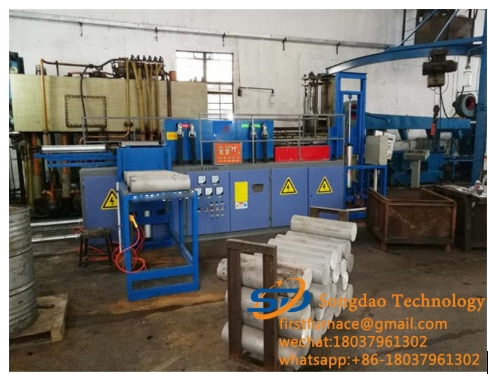- 06
- Nov
Aluminum rod forging induction heating furnace
Aluminum rod forging induction heating furnace
The induction heating furnace for aluminum rod forging is a furnace specially designed and manufactured for the heating and forging of aluminum rods. Due to the inherent characteristics of aluminum, the aluminum rod forging induction heating furnace needs to take some special measures in the design and manufacturing to ensure the normal and stable operation of the aluminum rod induction heating.

1. Heating temperature of induction heating furnace for aluminum rod forging
Because the deformation resistance of aluminum rods increases with decreasing temperature. During the heating process, the temperature increases faster than carbon steel and low-alloy steel, and the temperature heating range is narrow. In addition, when the temperature is too high or low during die forging, aluminum alloy forgings are prone to defects. Therefore, the aluminum alloy forging temperature range is narrow, and the aluminum rod forging induction heating furnace must meet the process requirements, and the forging heating temperature cannot be too high or low.
2. Precision measurement of heating temperature of induction heating furnace for aluminum rod forging
Because the aluminum rod forging temperature range is very narrow, and it is heated to about 400 degrees, the color of the aluminum alloy does not change, and the temperature cannot be judged with the naked eye. For this reason, the aluminum alloy heating needs to use an infrared thermometer to measure the surface temperature of the aluminum rod. Therefore, it is very important to measure the temperature of the aluminum rod forging induction heating furnace and the temperature of the blank, and it must be measured accurately.
3. Long heating and holding time for aluminum rod forging induction heating furnace.
Due to the complex metallurgical structure of aluminum alloy, in order to ensure that the strengthening phase is fully heated, the heating and holding time is longer than that of ordinary carbon steel, and the degree of alloying is higher. The longer the holding time. The heating and holding time is reasonable, the plasticity of aluminum alloy is good, and the forging performance of aluminum alloy can be improved. Holding time is longer than carbon steel
Four, aluminum rod forging induction heating furnace heating without oxide skin
Aluminum rod forging induction heating furnace does not produce loose oxide scale when heating aluminum alloy, but the product produces oxide film.
5. Aluminum rod forging Induction heating furnace heating aluminum rod has a lower cold shrinkage rate (compared to steel).
The cold shrinkage rate of aluminum alloy is smaller than that of steel, generally 0.6-1.0% (steel generally takes 1%-1.5%).
Although the forgeability of aluminum alloy is worse than that of carbon steel and low-alloy structural steel, it can be extremely good as long as the aluminum rod forging induction heating furnace heats the aluminum alloy billet with reasonable forging temperature, low mold roughness, good lubrication, and good mold preheating. Greatly improve the forgeability of deformed aluminum alloys, and forge precision die forgings with complex shapes.
